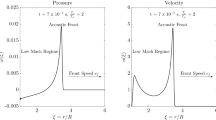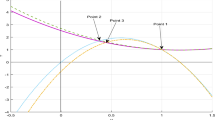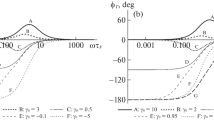Summary
An inert compressible gas confined between infinite parallel planar walls is subjected to significant heat addition at the boundaries. The wall temperature is increased during an interval which is scaled by the acoustic time of the container, defined as the passage time of an acoustic wave across the slab. On this time scale heat transfer to the gas occurs in thin conductive boundary layers adjacent to the walls. Temperature increases in these layers cause the gas to expand such that a finite velocity exists at the boundary-layer edge. This mechanical effect, which is like a time-varying piston motion, induces a planar linear acoustic field in the basically adiabatic core of the slab. A spatially homogeneous pressure rise and a bulk velocity field evolve in the core as the result of repeated passage of weak compression waves through the gas. Eventually the thickness of the conduction boundary layers is a significant fraction of the slab width. This occurs on the condition time scale of the slab which is typically a factor of 106 larger than the acoustic time. The further evolution of the thermomechanical response of the gas is dominated by a conductive-convective balance throughout the slab. The evolving spatially-dependent temperature distribution is affected by the homogeneous pressure rise (compressive heating) and by the deformation process occurring in the confined gas. Superimposed on this relatively slowly-varying conduction-dominated field is an acoustic field which is the descendent of that generated on the shorter time scale. The short-time-scale acoustic waves are distorted as they propagate through a slowly-varying inhomogeneous gas in a finite space. Solutions are developed in terms of asymptotic expansions valid when the ratio of the acoustic to conduction time scales is small. The results provide an explicit expression for the piston analogy of boundary heat addition.
Similar content being viewed by others
References
Lord Rayleigh, On the conduction of heat in a spherical mass of air confined by walls at a constant temperature,Phil. Mag. XLVII (1899) 314–325.
T.Y. Wu, Small perturbations in the unsteady flow of a compressible, viscous and heat conducting fluid,J. Math. Phys. 35 (1956) 13–27.
L. Trilling, On thermally induced sound fields,J. Acoustical Soc. Am. 27 (1955) 425–431.
J.R. Knudsen, The effects of viscosity and heat conductivity on the transmission of plane sound waves,J. Acoust. Soc. Am 26 (1957) 51–57.
A.V. Luikov and B.M. Berkoresky, Thermoconvective waves,Int. J. Heat Mass Transfer 13 (1970) 741–747.
B.T. Chu, Pressure waves generated by addition of heat in a gaseous medium, NACA-TN 3411 (1955), National Advisory Committee for Aeronautics, Washington D.C.
B.K. Larkin, Heat flow to a confined fluid in zero gravity,Progress in Astronautics and Aeronautics, Thermophysics of Space and Planetary Bodies, ed. G.B. Heller, 30 (1967) 819–832.
V. Thuraisamy, Thermodynamic flow of supercritical oxygen in zero-gravity,Bellcomm. TM-72–1022–1, (1972) Bellcomm. Inc., Washington, D.C.
L.W. Spradley, S.V. Bougeois, C. Fan and P.G. Grodzka, A numerical solution for thermoacoustic convection of of fluids in low gravity,NASA Contractor Rept. CR-2269, (1973) NASA, Washington, D.C.
L.W. Spradley and S.W. Churchill, Pressure and buoyancy driven thermal convection in a rectangular enclosure,J. Fluid Mech. 70 (1975) 705–720.
D.R. Kassoy, The response of a confined gas to a thermal disturbance: Slow transients,SIAM J. Appl. Math. 36 (1979) 624–634.
A.M. Radhwan, The mechanical response of a gas to boundary heat addition, Ph.D. Thesis, The University of Colorado (1981), Boulder, Colorado.
N. Rott, Thermoacoustics,Adv. in Appl. Mech. 20 (1980) pp. 135–174.
W.G. Vincenti and S.C. Traugott, The coupling of radiative transfer and gas motion,Ann. Rev. Fluid Mech. 3 (1971) 89–116.
H.S. Carslaw and J.C. Jaeger,Conduction of heat in solids, 2nd edn. (1978) Oxford University Press, Oxford, England.
M. Abramowitz and I. Stegun,Handbook of mathematical functions, National Bureau of Standards (1965), Washington D.C.
R.V. Churchill,Operational mathematics, 2nd edn. (1958), McGraw-Hill Book Co., New York.
E.L. Ince,Ordinary differential equations, (1956), Dover Publications, New York.
R.L. Ketter and S.P. Prawel,Modern methods of engineering computation, (1969), McGraw-Hill Book Co., New York.
J.D. Cole,Perturbation methods in applied mathematics, (1968), Blaisdell Pub. Co., Waltham, Mass.
J.F. Clarke, D.R. Kassoy and N. Riley, Weak shock generation in a confined gas due to rapid heat addition at the boundary, to appear inProc. Royal Soc. A (1984).
Author information
Authors and Affiliations
Rights and permissions
About this article
Cite this article
Radhwan, A.M., Kassoy, D.R. The response of a confined gas to a thermal disturbance: rapid boundary heating. J Eng Math 18, 133–156 (1984). https://doi.org/10.1007/BF00042732
Received:
Issue Date:
DOI: https://doi.org/10.1007/BF00042732




